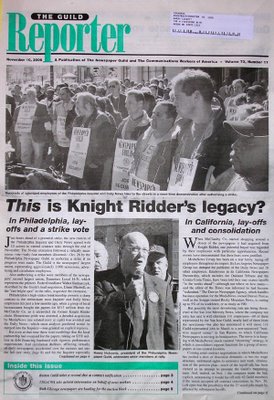GUILD AGREES ON NON-ECONOMIC ISSUES
PHILADELPHIA - The largest union at Philadelphia's two biggest newspapers has reached a tentative agreement with management on non-economic issues of a contract after
 a second day of marathon negotiations, union officials said early Monday.
a second day of marathon negotiations, union officials said early Monday.Henry Holcomb, president of the Newspaper Guild of Greater Philadelphia, cautioned that critical economic issues, including management's proposal to freeze pensions, remain unresolved.
The sides met for 12 hours, ending talks at 12:40 a.m. Monday, after a 14-hour session Saturday in which both sides reported some progress.
"I'm not going to be relieved until we get a complete agreement and get the members to ratify it," Holcomb said.
See Phila Strike News by AP
KIEITH OLBERMANN'S DELIVERS HOT NEWS
If you picked up the New York Times on October 18, you'd have had little reason to think it was a particularly significant day in American history. While the front page featured a photo of George W. Bush signing a new law at the White House the previous day, the story about the Military Commissions Act--which the Times never named--was buried in a 750-word piece on page A20. "It is a rare occasion when a President can sign a bill he knows will save American lives" was the first of several quotes of praise from the President that were high up in the article. Further down, a few Democrats objected to the bill, but from the article's limited explanation of the law it was hard to understand why.
But if you happened to catch MSNBC the evening before, you'd have heard a different story. It, too, began with a laudatory statement from the President: "These military commissions are lawful. They are fair. And they are necessary." Cut to MSNBC anchor Keith Olbermann: "And they also permit the detention of any American in jail without trial if the President does not like him."
See story in the Nation.
WALL STREET JOURNAL IS ABOUT TO SHRINK
The Wall Street Journal, is about to shrink.
Starting Jan. 2, The Journal, the nation’s second-highest-circulation daily after USA Today, will shrink in width by 3 inches, to an industry standard of 12 inches, reducing the space devoted to news by 10 percent.
The move has alarmed some journalists there, but executives say it will save millions of dollars and that the reconfigured Journal will offer more information, not less. They are unveiling the new design today.
On the front page, the column of news that runs down the left side will be gone. This thrusts the shaded, double-column "What's News" summary columns, the best-read part of the paper, into even greater prominence. With the front page already displaying advertising, the redesigned version will have room to begin only three or four articles.
Inside the paper, items that Journal editors deem "yesterday's news" will be condensed into brief text bits and graphics. Articles will include summary boxes.
See: Katharine Seelye’s story in The New York Times
EVEN POYNTER’S ST. PETE SUFFERS
The St. Petersburg Times is perhaps the finest daily newspaper south of The Washington Post and east of The Dallas Morning News.
The St. Petersburg Times and its owner, the Poynter Institute for Media Studies, provide a shining example of how a newspaper can be run without corporate bean counters ruling the day. The Times is a for-profit enterprise, but Poynter is not. That means the paper is better equipped to get through difficult financial times without having to resort to the slash-and-burn tactics all too commonly deployed by newspapers owned by publicly traded media companies.
Newspapers everywhere are losing readers, and the Times is no different. The paper's circulation in its home base of Pinellas County has deteriorated in recent years, largely offset by readership gains in other parts of the Tampa Bay area. But average weekday circulation slipped 3.2% year-on-year during the six months ended Sept. 30, according to the Audit Bureau of Circulations.
The Times has also been forced to cut costs in ways that will sound familiar to journalists elsewhere, such as by shrinking the size of the paper to save on newsprint costs; eliminating the quarterly cost-of-living increases once granted regularly to all staffers; and ditching the paper’s traditional pension plan for new hires and replacing it with a less costly 401(k).
And things are about to get a lot rougher. Executive Editor Neil Brown warned recently in the Times' in-house newsletter that the paper’s profits this year “if there are any, will be dangerously low.” As a result, the paper plans to eliminate 80 to 90 jobs companywide by the end of 2007, mostly through attrition.
See story in Forbe Magazine
Go to the Guild Reporter web site.
No comments:
Post a Comment